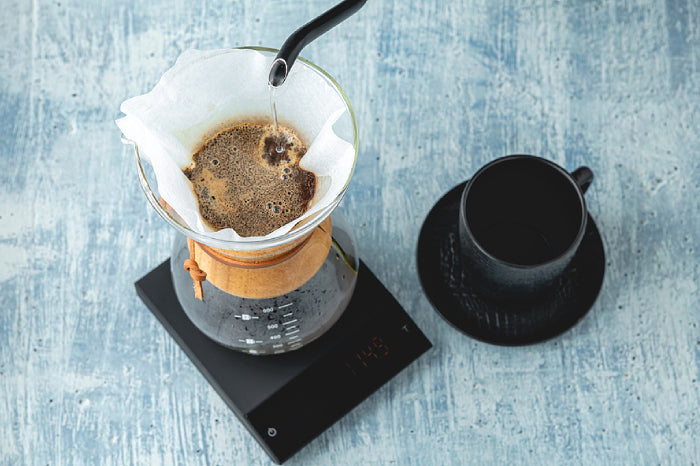Pour Over vs. Immersion Brewing: What Is The Difference?

If you have been a coffee drinker for a long time now, you probably began your coffee journey with a simple percolator. However, if you are a budding coffee connoisseur, it is about time that you consider graduating into a manual brewing process, which enables you to have more control over the variables that can change or affect your coffee’s flavour.
When it comes to coffee brewing, two processes often stand out: pour over and immersion. People who brew coffee at home commonly use these brewing methods to make their coffee. To know how these processes are distinct from each other, this article explores the main differences between pour over and immersion coffee brewing.
What is pour over brewing?
Pour over brewing is among the most popular methods of manual coffee brewing. As its name suggests, this method involves simply pouring water through the coffee grounds and a filter. It lets the grounds sit in the water for a specific amount of time before filtering them out.
Compared to immersion brewing, pour over brewing is usually completed faster, as it involves continuously introducing new and freshwater to the coffee grounds, which hastens the brewing process. However, in some instances, the continuous introduction of water can also extract too much flavour from the grounds too rapidly. This results in a decreased quality of the coffee. To avoid this, pour brewing should be done properly.
How to make a pour over coffee?
To make a pour over coffee, you will need various tools, such as a kettle, thermometer, burr grinder, and gram scale (optional). Light roast or medium roast coffee beans are ideal for pour over brewing, as the process makes their flavours genuinely shine. In terms of grinding, it is best to have the size of your coffee grounds relatively coarse.
The first step to brewing a pour over coffee is to wet the grounds by placing them in the filter and pouring just enough water to soak them without allowing the water to run through into the basin underneath. Let the wet coffee grounds sit for around 30 seconds to enable them to release all the carbon dioxide trapped inside. Otherwise, the water will not be able to completely penetrate the grounds, resulting in a weak or watery coffee.
After you are done wetting the coffee grounds and letting them sit for 30 seconds, you should continue pouring hot water over the filter. Your pace depends on your coffee beans’ roast level. If you are using light or medium roast beans, the total brewing time should be 3 to 4 minutes. On the other hand, for darker roast beans, 90 seconds to 3 minutes of total brewing time is recommended.
What is immersion brewing?
Immersion brewing is another popular method for brewing coffee manually. As its name suggests, immersion brewing is done by immersing coffee grounds with water. You can use various coffee devices, such as an Aeropress, a Clever Dripper, and a French Press.
What is great about this method of manual coffee brewing is that it allows you to have control over several variables, such as the size of the coffee grounds, the water’s temperature, and the amount of time that the water and the coffee grounds interact. Once you are ready with everything, you have to pour the mixture through a filter, and you will already have a flavourful cup of immersion brewed coffee.
How to make an immersion brewed coffee?
As mentioned earlier, there are a lot of different tools you can use to make an immersion brewed coffee, but the most common device many people use is the French Press. To use a French Press, you need to heat some water and prepare the coffee grounds.
Put the coffee grounds in the cylinder, pour the water in, and press the plunger down until all the grounds are submerged. Wait for around 4 minutes before pressing the plunger all the way down. After the time is over, pour the coffee into a cup, and enjoy!
Aside from a hot cup of coffee, you can also make a cold brew coffee using a French Press. The process of creating an immersion brewed cold coffee is relatively straightforward. All you have to do is immerse the coarse coffee grounds in cold water, cover the brewing vessel, place it in the fridge or on the counter, wait for about 12 to 15 hours, and strain. Because it is relatively easy to make, the popularity of cold brew coffee in Singapore is not surprising at all.
Conclusion
Manual brewing methods, such as pour over and immersion brewing, are an excellent way to develop your inner coffee connoisseur. They allow you to experiment with various water temperatures, ground sizes, and water-to-coffee ratios. By knowing the difference between pour over and immersion brewing methods, you can now find the formula for your perfect cup (or bottle) of coffee more easily!
If you do not have time to brew your own coffee, you do not have to worry because there are plenty of cold brew coffee delivery services. But for the best and most flavourful cold brew coffee, Wake The Crew is the brand you should choose! With years of experimentation, we have developed and perfected a cold brewing method that will surely bring out the healthiest components and tastiest flavours of your coffee! Avail our cold brew delivery in Singapore now to taste the best cold brew in town.

Leave a comment